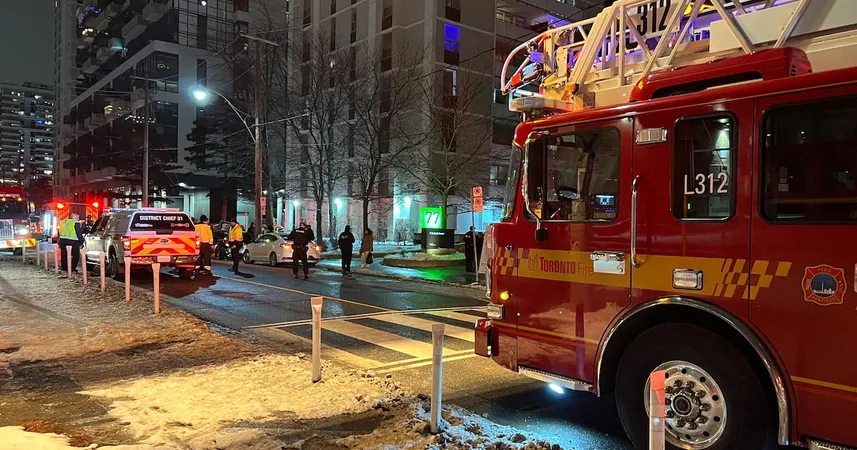
Is Southeast Florida's Luxury Real Estate on the Verge of a Crisis? Scientists Warn of Sinking Buildings!
2024-12-23
Author: Benjamin
Recent Study Reveals Alarming Findings
In a shocking revelation, a recent study led by researchers from the University of Miami has uncovered that dozens of luxury condos and hotels in Southeast Florida are sinking at an alarming rate. The findings, covering the period from 2016 to 2023, highlight that 35 prominent structures, including renowned locations such as the Ritz-Carlton Residences, Trump Tower III, Trump International Beach Resorts, and the iconic Surf Club Towers, have subsided by as much as three inches.
Causes of Land Subsidence
According to the researchers, vibrations from ongoing construction are primarily responsible for this perilous phenomenon. The vibrations can cause soil particles to compact and settle, ultimately resulting in land subsidence—essentially the gradual sinking of the ground, akin to shaking coffee grounds to create more space.
Expert Insights
Senior study author Falk Amelung, a professor of geophysics at the University of Miami’s Rosenstiel School, expressed his surprise that the sinking continued for years beyond the initial construction. While minor movements after building was erected are often anticipated and accounted for by engineers, the fact that these structures are still sinking is an unsettling discovery.
Impact of Previous Disasters
This alarming study gained momentum following the catastrophic collapse of the Champlain Towers in Surfside, Florida in 2021. Although no signs of subsidence were detected before that tragedy, evidence was found in nearby beachfront buildings. Researchers utilized advanced satellite imaging to meticulously track minute shifts in the Earth’s surface, focusing on key structure points like balconies and rooftop AC units.
Regional Implications
The situation is even more precarious in areas like Sunny Isles Beach, where nearly 70% of buildings are sinking, with around 23% of them built in the last decade. In addition to construction vibrations, daily tidal activity contributes to the movement of the ground, worsening the buildings' plight. Other factors, including seismic activity and the compaction of soil— especially in regions where new land has been created by backfilling sediment—are also significant contributors.
Climate Change Considerations
The implications of these findings are particularly dire in the context of climate change. Miami is grappling with a dual issue: land subsidence coupled with rising sea levels, both of which amplify the city’s vulnerability to coastal flooding, storm surges, and erosion. Specifically, the study area experiences sea-level rise at an average rate of roughly 2.6 inches per decade, compounding the problem as many of the sinking buildings go down at a rate comparable to the sea level rise. This effectively doubles the impact of flooding risks in those locations, as noted by climate researcher Brian McNoldy.
Proactive Monitoring Measures
However, researchers Amelung and Manoochehr Shirzaei emphasize that there's no cause for panic. They point out that the satellite technology employed can proactively monitor the stability of these coastal structures. Shirzaei highlighted that unlike sea-level rise—which can be a broader, more difficult issue to tackle—local actions can be taken to address land subsidence. This technology allows for ongoing monitoring, akin to healthcare for buildings, enabling timely intervention before a catastrophic event occurs.
Future Considerations
The findings invite further investigations, as stakeholders in Southeastern Florida's real estate market grapple with the balance between luxurious living and environmental sustainability. As the region faces the existential threat of climate change, one must wonder: how will developers and homeowners respond to the reality of sinking buildings?









 Brasil (PT)
Brasil (PT)
 Canada (EN)
Canada (EN)
 Chile (ES)
Chile (ES)
 España (ES)
España (ES)
 France (FR)
France (FR)
 Hong Kong (EN)
Hong Kong (EN)
 Italia (IT)
Italia (IT)
 日本 (JA)
日本 (JA)
 Magyarország (HU)
Magyarország (HU)
 Norge (NO)
Norge (NO)
 Polska (PL)
Polska (PL)
 Schweiz (DE)
Schweiz (DE)
 Singapore (EN)
Singapore (EN)
 Sverige (SV)
Sverige (SV)
 Suomi (FI)
Suomi (FI)
 Türkiye (TR)
Türkiye (TR)